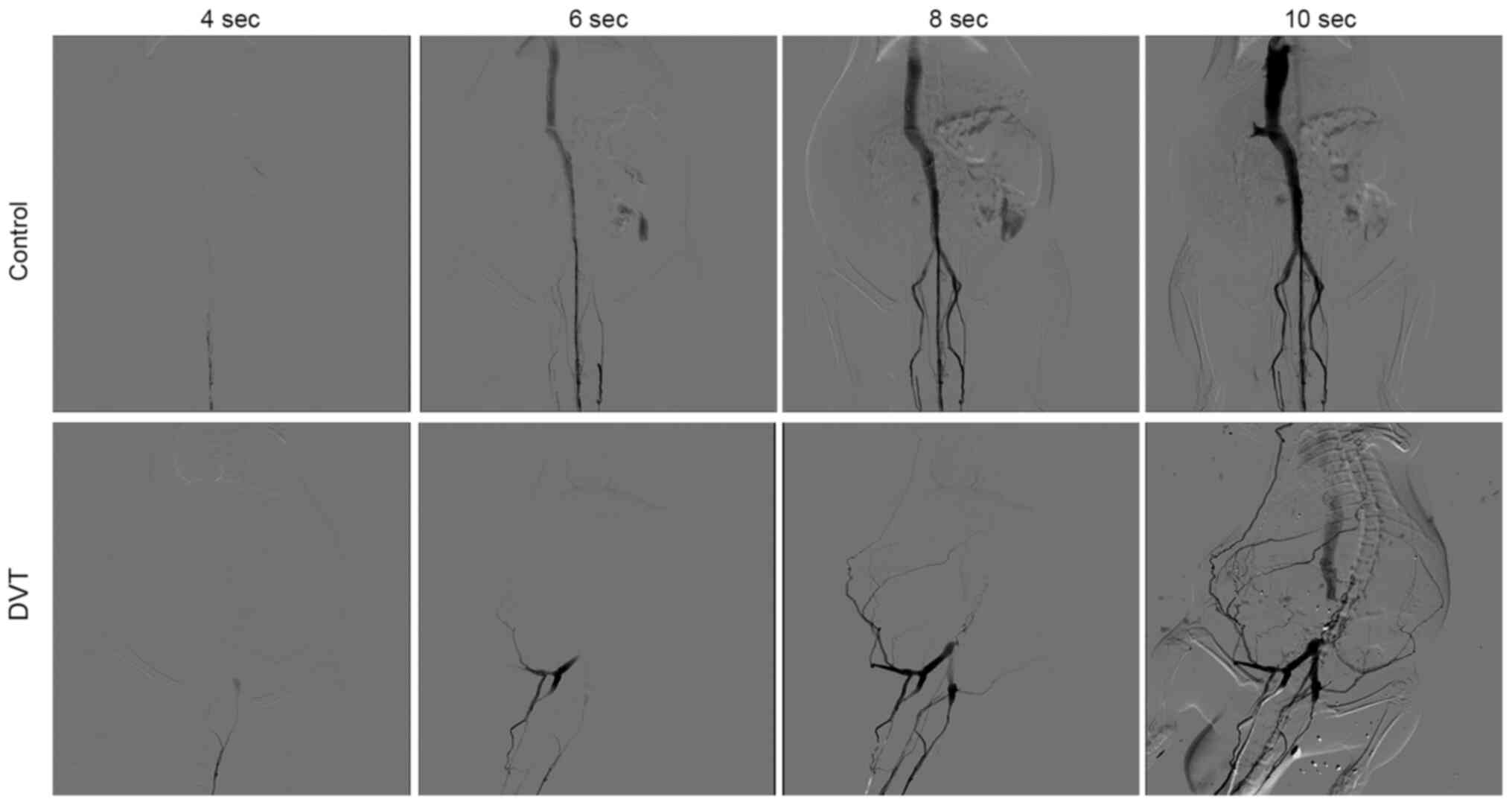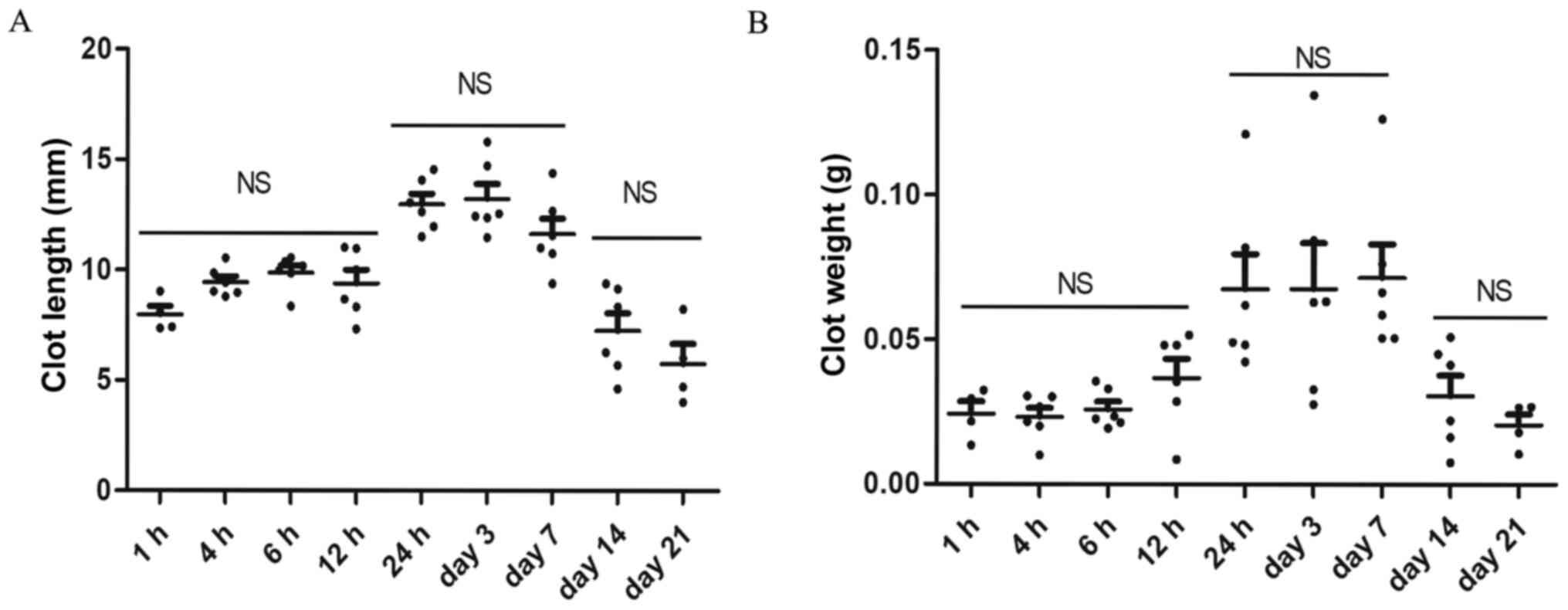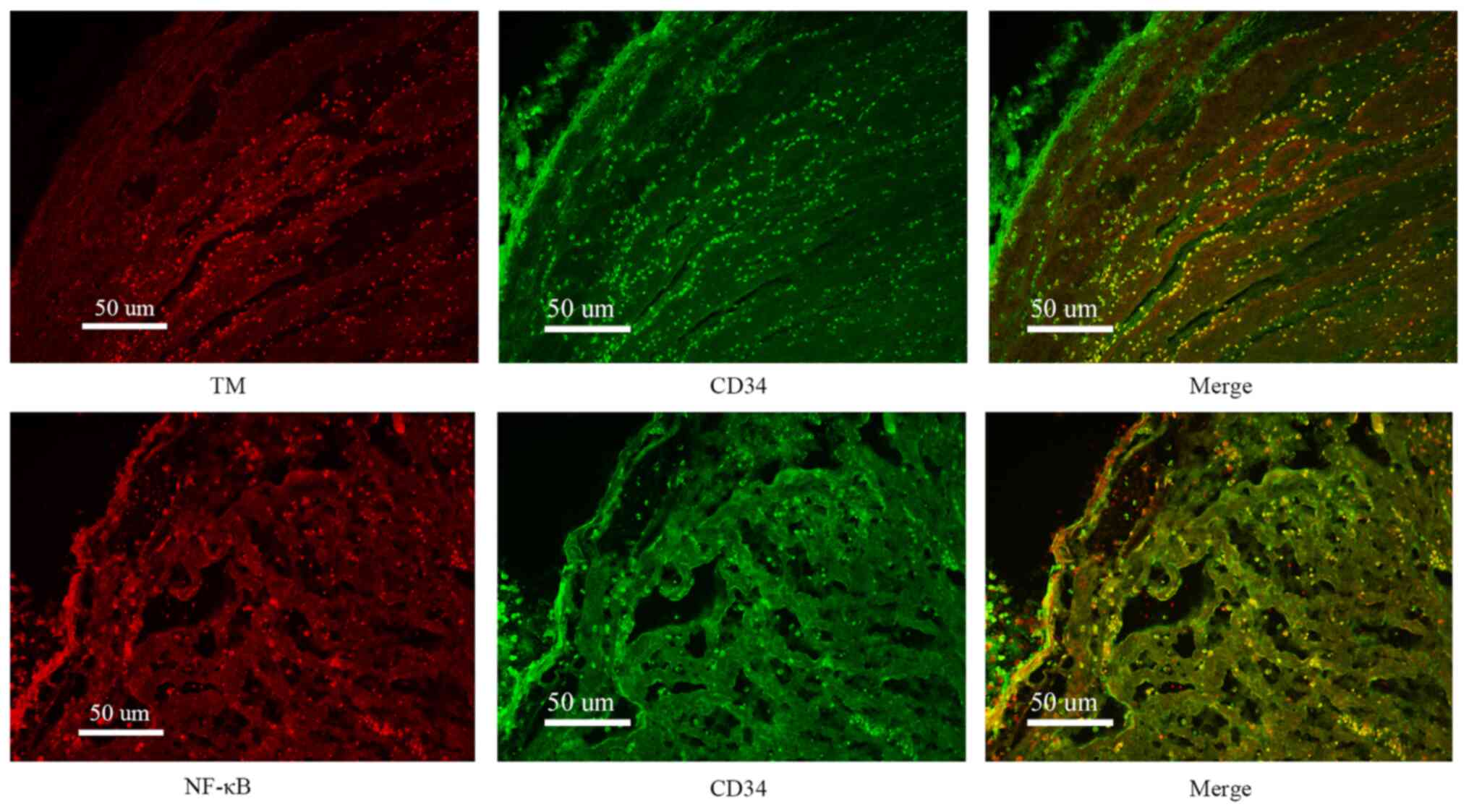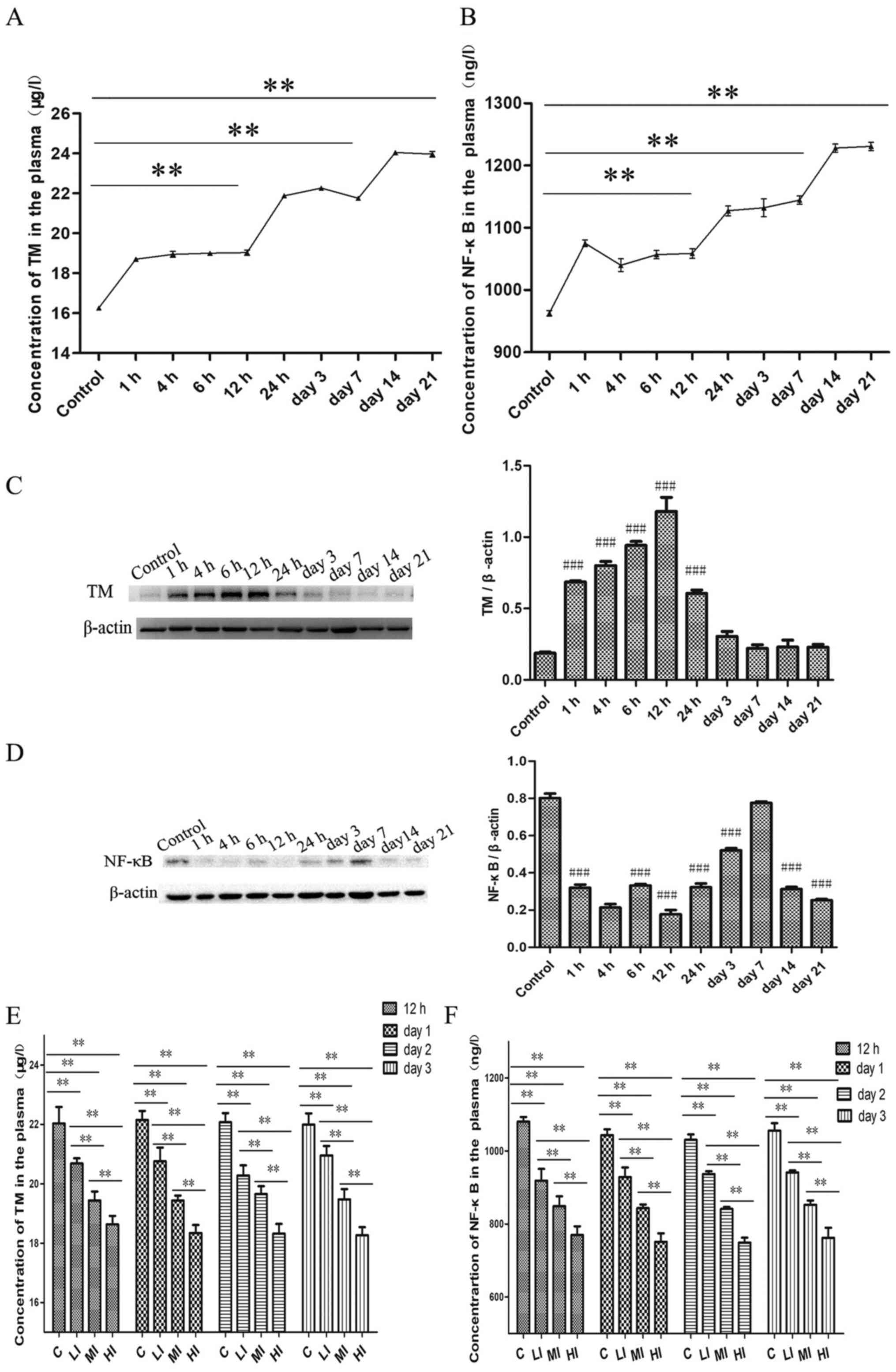|
1
|
Di Nisio M, van Es N and Büller HR: Deep
vein thrombosis and pulmonary embolism. Lancet. 388:3060–3073.
2016.PubMed/NCBI View Article : Google Scholar
|
|
2
|
Thomas M, Hollingsworth A and Mofidi R:
Endovascular management of acute lower limb deep vein thrombosis: A
systematic review and meta-analysis. Ann Vasc Surg. 58:363–370.
2019.PubMed/NCBI View Article : Google Scholar
|
|
3
|
Galanaud JP, Monreal M and Kahn SR:
Epidemiology of the post-thrombotic syndrome. Thromb Res.
164:100–109. 2018.PubMed/NCBI View Article : Google Scholar
|
|
4
|
Shin M, Hino H, Tamura M, Ishizuka B,
Tanaka M, Suzuki N and Tateda T: Thrombomodulin improves maternal
and fetal conditions in an experimental pre-eclampsia rat model. J
Obstet Gynaecol Res. 40:1226–1234. 2014.PubMed/NCBI View Article : Google Scholar
|
|
5
|
Anastasiou G, Gialeraki A, Merkouri E,
Politou M and Travlou A: Thrombomodulin as a regulator of the
anticoagulant pathway: Implication in the development of
thrombosis. Blood Coagul Fibrinolysis. 23:1–10. 2012.PubMed/NCBI View Article : Google Scholar
|
|
6
|
Fu Y, Liu Y, Chen S, Jin Y and Jiang H:
The combination of caprini risk assessment scale and thrombotic
biomarkers to evaluate the risk of venous thromboembolism in
critically ill patients. Medicine (Baltimore).
97(e13232)2018.PubMed/NCBI View Article : Google Scholar
|
|
7
|
Salvagno GL, Pavan C and Lippi G: Rare
thrombophilic conditions. Ann Transl Med. 6(342)2018.PubMed/NCBI View Article : Google Scholar
|
|
8
|
Hoesel B and Schmid JA: The complexity of
NF-κB signaling in inflammation and cancer. Mol Cancer.
12(86)2013.PubMed/NCBI View Article : Google Scholar
|
|
9
|
Zhang Q, Lenardo MJ and Baltimore D: 30
Years of NF-κB: A blossoming of relevance to human pathobiology.
Cell. 168:37–57. 2017.PubMed/NCBI View Article : Google Scholar
|
|
10
|
Shirai Y, Uwagawa T, Shiba H, Shimada Y,
Horiuchi T, Saito N, Furukawa K, Ohashi T and Yanaga K: Recombinant
thrombomodulin suppresses tumor growth of pancreatic cancer by
blocking thrombin-induced PAR1 and NF-κB activation. Surgery.
161:1675–1682. 2017.PubMed/NCBI View Article : Google Scholar
|
|
11
|
Ma J and Bai J: Protective effects of
heparin on endothelial cells in sepsis. Int J Clin Exp Med.
8:5547–5552. 2015.PubMed/NCBI
|
|
12
|
Wu CT, Chang YH, Lin P, Chen WC and Chen
MF: Thrombomodulin expression regulates tumorigenesis in bladder
cancer. BMC Cancer. 14(375)2014.PubMed/NCBI View Article : Google Scholar
|
|
13
|
Menschikowski M, Hagelgans A, Tiebel O,
Vogel M, Eisenhofer G and Siegert G: Regulation of thrombomodulin
expression in prostate cancer cells. Cancer Lett. 322:177–184.
2012.PubMed/NCBI View Article : Google Scholar
|
|
14
|
Song D, Ye X, Xu H and Liu SF: Activation
of endothelial intrinsic NF-{kappa}B pathway impairs protein C
anticoagulation mechanism and promotes coagulation in endotoxemic
mice. Blood. 114:2521–2529. 2009.PubMed/NCBI View Article : Google Scholar
|
|
15
|
Liang W, Wei F, Yang C, Xie F, Shuai XX,
Wang M and Yu M: GDF-15 is associated with thrombus burden in
patients with deep venous thrombosis. Thromb Res. 187:148–153.
2020.PubMed/NCBI View Article : Google Scholar
|
|
16
|
Yao X, Chen W, Liu J, Liu H, Zhan JY, Guan
S, Lu Z, Tang P, Li P and Lin B: Deep vein thrombosis is modulated
by inflammation regulated via sirtuin 1/NF-κB signalling pathway in
a rat model. Thromb Haemost. 119:421–430. 2019.PubMed/NCBI View Article : Google Scholar
|
|
17
|
Qin JD, Cao ZH, Li XF, Kang XL, Xue Y, Li
YL, Zhang D, Liu XY and Xue YZ: Effect of ammonium pyrrolidine
dithiocarbamate (PDTC) on NF-κB activation and CYP2E1 content of
rats with immunological liver injury. Pharm Biol. 52:1460–1466.
2014.PubMed/NCBI View Article : Google Scholar
|
|
18
|
Yin J, Wu M, Duan J, Liu G, Cui Z, Zheng
J, Chen S, Ren W, Deng J, Tan X, et al: Pyrrolidine dithiocarbamate
inhibits NF-KappaB activation and upregulates the expression of
Gpx1, Gpx4, occludin, and ZO-1 in DSS-induced colitis. Appl Biochem
Biotechnol. 177:1716–1728. 2015.PubMed/NCBI View Article : Google Scholar
|
|
19
|
Zhang Z, Hu L, Chen W, Zhou C, Gui G and
Lin B: Danhong huayu koufuye prevents deep vein thrombosis through
anti-inflammation in rats. J Surg Res. 201:340–347. 2016.PubMed/NCBI View Article : Google Scholar
|
|
20
|
Diaz JA, Obi AT, Myers DD Jr, Wrobleski
SK, Henke PK, Mackman N and Wakefield TW: Critical review of mouse
models of venous thrombosis. Arterioscler Thromb Vasc Biol.
32:556–562. 2012.PubMed/NCBI View Article : Google Scholar
|
|
21
|
Vukojevic J, Siroglavic M, Kasnik K, Kralj
T, Stancic D, Kokot A, Kolaric D, Drmic D, Sever AZ, Barisic I, et
al: Rat inferior caval vein (ICV) ligature and particular new
insights with the stable gastric pentadecapeptide BPC 157. Vascul
Pharmacol. 106:54–66. 2018.PubMed/NCBI View Article : Google Scholar
|
|
22
|
Sharma A, Fish BL, Moulder JE, Medhora M,
Baker JE, Mader M and Cohen EP: Safety and blood sample volume and
quality of a refined retro-orbital bleeding technique in rats using
a lateral approach. Lab Anim (NY). 43:63–66. 2014.PubMed/NCBI View Article : Google Scholar
|
|
23
|
Goicoechea M, Cía F, San José C, Asensio
A, Emparanza JI, Gil AG, López de Cerain A, Aldazabal P, Azpitarte
M, Otaegui D and López de Munain A: Minimizing creatine kinase
variability in rats for neuromuscular research purposes. Lab Anim.
42:19–25. 2008.PubMed/NCBI View Article : Google Scholar
|
|
24
|
Bagot CN and Arya R: Virchow and his
triad: A question of attribution. Br J Haematol. 143:180–190.
2008.PubMed/NCBI View Article : Google Scholar
|
|
25
|
Iba T and Levy JH: Inflammation and
thrombosis: Roles of neutrophils, platelets and endothelial cells
and their interactions in thrombus formation during sepsis. J
Thromb Haemost. 16:231–241. 2018.PubMed/NCBI View Article : Google Scholar
|
|
26
|
Vazquez-Garza E, Jerjes-Sanchez C,
Navarrete A, Joya-Harrison J and Rodriguez D: Venous
thromboembolism: Thrombosis, inflammation, and immunothrombosis for
clinicians. J Thromb Thrombolysis. 44:377–385. 2017.PubMed/NCBI View Article : Google Scholar
|
|
27
|
Ochi A, Adachi T, Inokuchi K, Ogawa K,
Nakamura Y, Chiba Y, Kawasaki S, Onishi Y, Onuma Y, Munetsugu Y, et
al: Effects of aging on the coagulation fibrinolytic system in
outpatients of the cardiovascular department. Circ J. 80:2133–2140.
2016.PubMed/NCBI View Article : Google Scholar
|
|
28
|
Bombeli T, Jutzi M, De Conno E, Seifert B
and Fehr J: In patients with deep-vein thrombosis elevated levels
of factor VIII correlate only with von Willebrand factor but not
other endothelial cell-derived coagulation and fibrinolysis
proteins. Blood Coagul Fibrinolysis. 13:577–581. 2002.PubMed/NCBI View Article : Google Scholar
|
|
29
|
Sane M, Granér M, Laukkanen JA, Harjola VP
and Mustonen P: Plasma levels of haemostatic factors in patients
with pulmonary embolism on admission and seven months later. Int J
Lab Hem. 40:66–71. 2018.PubMed/NCBI View Article : Google Scholar
|
|
30
|
Kalayci A, Gibson CM, Chi G, Yee MK,
Korjian S, Datta S, Nafee T, Gurin M, Haroian N, Qamar I, et al:
Asymptomatic deep vein thrombosis is associated with an increased
risk of death: Insights from the APEX trial. Thromb Haemost.
118:2046–2052. 2018.PubMed/NCBI View Article : Google Scholar
|
|
31
|
Kearon C, Comp P, Douketis J, Royds R,
Yamada K and Gent M: Dose-response study of recombinant human
soluble thrombomodulin (ART-123) in the prevention of venous
thromboembolism after total hip replacement. J Thromb Haemost.
3:962–968. 2005.PubMed/NCBI View Article : Google Scholar
|
|
32
|
Ayala-Ramírez P, Buitrago T, Poveda A,
Rodríguez JL, Olaya-C M and García-Robles R: Increased tissue
factor and thrombomodulin expression and histopathological changes
in placentas of pregnancies with preeclampsia. J Neonatal Perinatal
Med. 9:31–39. 2016.PubMed/NCBI View Article : Google Scholar
|
|
33
|
Li YD, Ye BQ, Zheng SX, Wang JT, Wang JG,
Chen M, Liu JG, Pei XH, Wang LJ, Lin ZX, et al: NF-kappaB
transcription factor p50 critically regulates tissue factor in deep
vein thrombosis. J Biol Chem. 284:4473–4483. 2009.PubMed/NCBI View Article : Google Scholar
|
|
34
|
Li G, Zhou R, Zhao X, Liu R and Ye C:
Correlation between the expression of IL-18 and deep venous
thrombosis. Int J Mol Med. 42(2972)2018.PubMed/NCBI View Article : Google Scholar
|
|
35
|
Deng HF, Wang S, Li L, Zhou Q, Guo WB,
Wang XL, Liu MD, Liu K and Xiao XZ: Puerarin prevents vascular
endothelial injury through suppression of NF-ΚB activation in
LPS-challenged human umbilical vein endothelial cells. Biomed
Pharmacother. 104:261–267. 2018.PubMed/NCBI View Article : Google Scholar
|



















